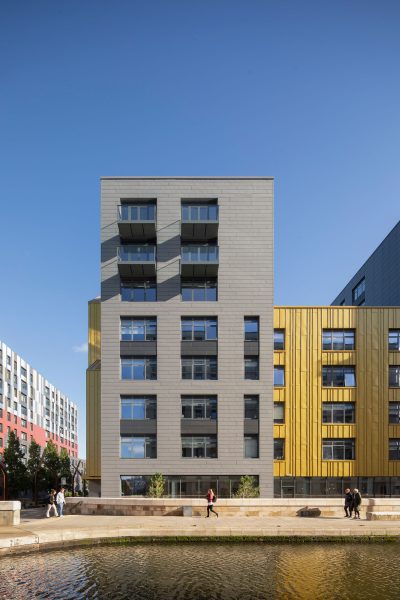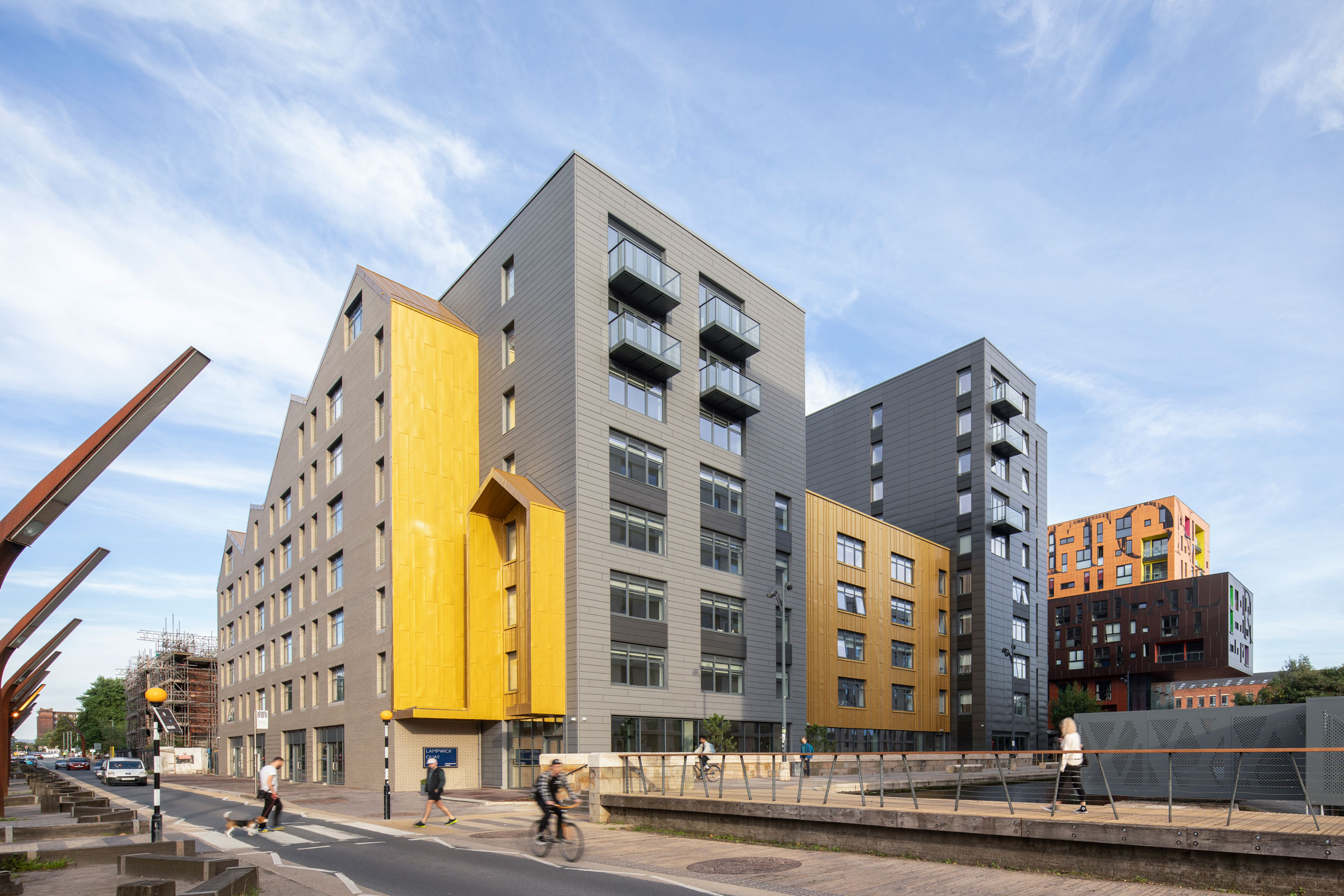Story at a glance:
- Zinc’s natural patina cuts life cycle costs and maintenance.
- Zinc is fully recyclable and more energy-efficient to produce than most metals.
- Arcadis designed Lampwick Quay in Manchester using multiple zinc techniques.
The opening ceremony of this summer’s Paris Olympics featured a striking moment: a masked torchbearer leaping across the city’s iconic zinc rooftops. This vivid scene wasn’t just a celebration of architectural heritage; it subtly underscored why zinc is rapidly gaining favor in green building.
Built to Last
Zinc has a long history, especially in European architecture, where its durability is legendary. Parisian rooftops, some more than a century old, exemplify that longevity. “There are not many roofs you can put up that you can say will last over 100 years,” says Mike LeRoy, general manager for VMZINC North America.
Viewed through a modern lens of sustainability, zinc’s resilience is seen as a way to contribute to lower life cycle costs, reduced waste, and decreased energy use in mining and transportation.
Protective Patina
Zinc’s longevity largely stems from its natural patina—a layer of zinc carbonate that forms as the material reacts with the environment. This protective layer enhances corrosion resistance but also has a self-healing quality that fills in scratches and imperfections, reducing maintenance needs over time.
It also results in a gradual color transformation, transitioning from a shiny metallic to a soft matte gray.
“It has quite a warm feeling, which sounds strange to say … that a metal feels warm,” says Matt Pickering, associate principal at Arcadis in Manchester, England.
Natural and Recyclable

Zinc is fully recyclable and more energy-efficient to produce than most metals. The material’s malleability enables a range of innovative architectural uses. Photo by Joseph Lombardi
As the 23rd most abundant element in the Earth’s crust, zinc is widely available. But for architectural applications, pure zinc is too soft and brittle, so it’s often alloyed with titanium and copper for modern building needs.
One standout feature is its 100% recyclability. “You can recycle zinc at any point in its lifetime,” LeRoy says. “We often recycle it at the pre-consumer stage in the plants, with scraps that accumulate.” Post-consumer recycling is also common, he says. “Old stock can be shipped back to our facilities, melted down, and added to new zinc.”
This closed-loop cycle reduces the need to mine new ore, conserving resources and energy.
Metal Matchup
That’s why zinc seems to be increasingly favored over other metals like aluminum, copper, and steel. Its sustainability benefits make it a compelling alternative, especially in institutional and high-end residential markets where durability and long-term savings are priorities.
“The demand is widespread,” LeRoy says. “We see it with a lot of institutional work—schools, churches, colleges, and universities. And then there’s the high-end residential market, which is really liking zinc as well.”
While zinc’s upfront costs can be higher than materials like steel or aluminum, its longevity and low maintenance can make it a cost-effective choice over time. “It’s going to last longer than aluminum or steel,” LeRoy says.
Additionally, zinc production is more energy-efficient, requiring half the energy of copper and a fifth of what it takes to produce aluminum, LeRoy says.
Arcadis’ Pickering says end-user demand is another factor. “Institutional investors are very aware that a tenant will now choose an environmentally sustainable building over a non-sustainable one,” he says. And that is driving material choices like zinc.
Versatility in Design

Lampwick Quay in Manchester was designed by Arcadis. Photo by Paul Karalius
In terms of aesthetics, zinc’s malleability allows for various design applications. Historically used for roofing, zinc is now popular in cladding, rainwater systems, and even interior applications like perforated panels and bar tops. “Zinc can be used just about anywhere on a building,” LeRoy says.
One notable example is the Lampwick Quay project in Manchester. Designed by Arcadis, this multi-family apartment development employs multiple zinc techniques to convey a sense of evolving scale.
The building prominently features traditional standing seam panels in gold, which serves as its focal point. Behind this, lighter gray interlocking planks add texture and depth. Further back, larger panels create a more expansive and simplified look.
The design achieves a detailed, residential scale at street level, transitioning to a more substantial, warehouse-inspired look as you move back. “It gives the building a real identity of its own,” Pickering says.
One of the chief goals of the project was to ensure favorable operational running costs. That was achieved in part through large mineral wool panels behind the zinc for insulation. “The use of zinc was great for our thermal envelope and in keeping the running costs down,” Pickering says.
Efficiencies in Design
Maximizing sustainability through design often involves optimizing the form and orientation of the building. But LeRoy emphasizes the importance of optimizing the zinc as well. “The more you optimize the panel sizes, the more of the zinc you’re using, and the less waste you produce,” he says.
Integrating renewable energy technologies like photovoltaics in a standing seam roof can further boost sustainability.
Hurdles with Zinc
Despite its many benefits, zinc also faces challenges.
Initial costs can be higher than some traditional materials, though long-term savings in maintenance and energy efficiency often offset this. And, as Alex Pittman, technical manager for VMZINC, points out, perceptions of zinc costs may differ from reality.
“When zinc first entered the North American market, the higher cost was due to a lack of familiarity among installers. They didn’t know how to work with zinc, which inflated prices,” he says. “Now, two decades later, with many great projects and experienced installers, the cost has come down.”
Challenging Environments
Certain environments can also pose challenges for zinc, particularly coastal areas with saltwater exposure. But proper detailing can mitigate these issues, Pittman says, allowing zinc to develop a protective patina even in harsh conditions.
Understanding zinc’s compatibility with certain materials, like copper and certain high pH timbers, is also important to prevent staining and corrosion, Pittman says, noting that it’s important to work early in the process to ensure the zinc is set up for optimal performance.
Industry Role

550 Washington Street in Hudson Square, designed by COOKFOX Architects. Photo by Joseph Lombardi
The need to educate clients is also important, particularly in areas dominated by traditional materials. “In the UK the majority of building stock is red brick and slate tiles, and moving away from that can be met with resistance,” Pickering says. “Educating clients about the benefits of zinc, both aesthetically and in terms of sustainability, is crucial.”
Clients may also need reassurance about performance, especially with newer zinc products, Pickering says, but having a successful project to point to can make all the difference.
Where the industry can really help, Pickering says, is with a better focus on post-occupancy evaluations. “There’s a need for stronger assessments of how buildings perform after completion,” he says. “We can look at manufacturer data, but we also need to learn from end users about how these buildings are operating in [real-world conditions].”
This feedback is crucial for refining future designs and ensuring that zinc maintains its position as an invaluable sustainable ally—because the outlook is bright. “It’s really about how big the design world’s imagination is,” Pickering says.

